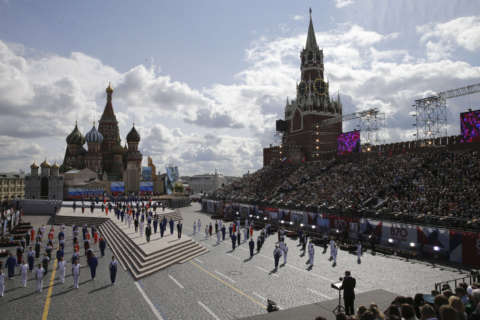About this series: The U.S. intelligence community has concluded that an attempt to interfere in the 2016 presidential election was ordered by Russian President Vladimir Putin. A WTOP investigation that began in November 2016 examined how the attack happened, when it started, who was involved and what’s next. Dozens of interviews with current and former U.S. intelligence officials, members of Congress, cybersecurity and intelligence experts, foreign government officials, Russian nationals and American victims were conducted. Here is what WTOP learned.
WASHINGTON — In the geopolitical haze that followed the collapse of the Soviet Union, the surviving Russian government promptly launched attempts to undermine the U.S. government from inside out, sources with detailed knowledge of Russia’s plans and operations told WTOP.
According to a top former U.S. counterintelligence official, the U.S. State Department itself gave Russian agents arguably the best opportunity to execute an attack on U.S. soil.
“In 1991–92, senior members of the State Department felt as though old Russia was gone, a new Russia was emerging — ‘they’re friends; we can work with them,’” the official said.
That mentality opened the door to a series of U.S. government mistakes, said Robert Booth, former deputy director of counterintelligence in the State Department’s Bureau of Diplomatic Security (DS).
“Unfortunately, that led to the decision that Russian diplomats who visited the State Department did not have to be escorted when they showed up at the main State Department facility,” Booth said. “They were allowed to walk around inside the State Department and alone.”
Counterintelligence authorities attempted to warn State Department officials.
“My office and the FBI were aware of what was going on. In fact, we had an operation [in] which we monitored the Russian diplomats walking around outside the State Department and we tried to alert our senior members to this situation,” Booth said, “but we were somewhat rebuffed.”
Then all of a sudden, Booth’s DS team and the FBI noticed that the Russian diplomat’s visits to the State Department had stopped suddenly.
But the damage had already been done.
“It became clear later on to us that the operation they had run was over with,” Booth said. “They had successfully introduced a listening device into a conference room [on] the seventh floor of the State Department.”
The device was discovered in 1999, eight years after Booth and his colleagues warned of suspicious activity.
The mistake of granting unfettered access inside the State Department
Taking advantage of U.S. naiveté, Russian diplomats and ostensibly intelligence operatives were able to roam around the U.S. State Department headquarters in the early 1990s. They were able to take notes and collect intelligence.
And some experts believe they made friends who would assist them in pulling off the most stunning intelligence feat of the time: The KGB was able to install a listening device in a conference room outside the secretary of state’s office.
“It was concealed inside a fake piece of chair rail molding,” said Booth.
Russians attended bilateral and trilateral meetings with their American counterparts in that room.
“Obviously”, Booth said, “one or two of those Russian diplomats were intelligence officers under diplomatic cover. They were able to get a picture and determine the exact color and specifications of that chair molding. It went back to Moscow. Moscow duplicated it and put a listening device with batteries on the inside.”
At that point, the most troubling of all of the KGB’s clandestine movements took place.
“The Russians were able to come back into the conference room later on, remove the original chair rail molding and substitute the fake one with the listening device,” Booth said.
The swap still bedevils many intelligence and security officials.
“The case is still an open case 20 years later,” Booth told WTOP on Aug. 14. “There is great debate. There is simply no question that the Russians had unimpeded access to that room on at least two if not three occasions. They had to have been to be in there alone.”
That fact that Russian diplomats were allowed to move around unescorted inside the State Department possibly solves the question of how they were able to access the conference room. But for Booth and others, that does not mean the Russian “diplomats” were actually the ones able to place the bug in the chair.
“We have some ideas of how that may have happened,” he said. “There are some in [the] intelligence community who believe the Russians did that all by themselves. The other 50 percent, including me, believes they had help on the inside.”
A high-level U.S. intelligence source with deep knowledge of Russian spy craft agrees with Booth.
“I believe the Russians used an auxiliary asset to replace the piece of authentic molding with the one containing a bug. Any cleaning lady could easily do it. A good motivation would be something like $50,000,” said the source.
‘Russians didn’t do it themselves’
The source, who spent decades in Russia, in close proximity to KGB thinking, told WTOP: “I am sure this was the case. Russians didn’t do it themselves; it would be an unjustified suicidal mission.”
The source even detailed the likely steps employed.
“Step one: Take a good quality photo and measurements. Step two: Make two almost invisible incisions with the tool provided by the KGB handler. Step three: Take the old piece out and put the new one in. Each step takes no more than two minutes. With minimal training and reasonable precautions, it would’ve been a piece of cake,” the source said.
It’s not clear how long the listening device was in place — but it could possibly have been years.
As for the tactics the Russian agents used, and how they could’ve created the climate for the 2016 election meddling operation, Dr. Christopher Paul, a senior social scientist at the Rand Corp. told WTOP, “When you talk about Russia, remember that this is a nation of chess players.”
“There are two critical aspects to chess,” Paul said. “One is thinking tens if not dozens of moves ahead, and planning meticulously the way things unfold. The other is opportunism because chess is a two-player game. If your opponent makes a mistake, you can exploit that.”
Allowing Russian agents to meander freely inside the State Department may have been the break the KGB sought in its quest to meddle in U.S. politics, but which was never able to achieve during the Cold War.








